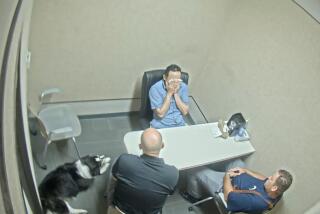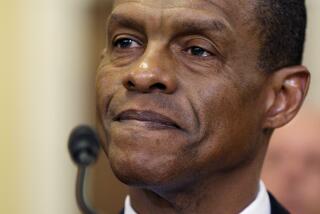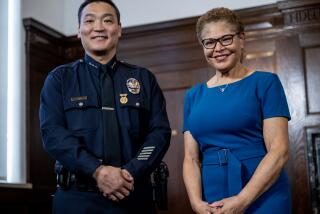Delay of Ezell Ford autopsy report dredges up old fears about LAPD
A new piece of the puzzle that is the death of Ezell Ford landed this week with the public release of his autopsy report.
The coroner’s account explains what killed Ford: His body bore three bullet holes — in the arm, side and back, where the gun was so close to him when it went off, it left a muzzle imprint on his skin.
The report labels his death a homicide. “Shot by officer(s) during altercation,” it says.
But medical science can’t tell us what led police to shoot the unarmed 25-year-old, whose family said he’d been diagnosed with schizophrenia and bipolar disorder.
That South Los Angeles tragedy became our touchstone in the national “Black Lives Matter” campaign, which followed the police killings of Michael Brown in Ferguson, Mo., and Eric Garner in New York. Ford’s death in August — just days after Brown’s — led to local protests that have been fueled since then by an absence of information and what some consider stonewalling by the LAPD.
The department had placed a hold on Ford’s autopsy report but was ordered by Mayor Eric Garcetti to allow its release.
LAPD Chief Charlie Beck was concerned that witnesses might try to align their stories with physical evidence gleaned from the coroner’s exam; going public with that report might taint the investigation, he said.
But depriving the public of that information stands to taint something just as important — the fragile relationship between police and a community where residents have a different take on the chief’s concern:
Why did it take four months to make the autopsy public? Because cops needed time to study the report and make sure that their stories line up.
::
LAPD Cmdr. Bob Lopez understands why people might be suspicious. “It’s human nature because of the things that have gone on in the past,” said Lopez, who heads the LAPD unit that examines every officer-involved shooting. “There will always be people who are skeptical.
“But the amount of investigation and the scrutiny it gets makes this one of the most intense investigations the department does. It’s very painstaking,” he said. “It can’t be rushed.”
Investigations take longer here than in other cities, in part because of requirements dictated by the consent decree imposed on the LAPD in the wake of the misconduct revelations tied to the Rampart scandal.
“That took it to another level,” Lopez said. “I don’t think any [police department] across the United States does a report as thoroughly as we do it here.”
Lopez walked me through the process, which typically takes about eight months and involves teams from the LAPD, the district attorney’s office and the inspector general, the department’s civilian monitor whose office studies the investigative reports, prepares a separate evaluation and posts the rulings in each case online.
“We all roll out to shooting scenes,” Lopez said, to question the officers, interview eyewitnesses and collect forensic evidence, including bullet casings and blood swabs.
After that it might take weeks or months to track down witnesses, transcribe their comments and examine conflicts among the accounts. “People will say, ‘I heard 15 shots,’ but only five were fired, so we have to note that,” Lopez explained. “Someone will say, ‘I was here and my friend was over there,’ so that leads to a new witness we have to pursue. The trail doesn’t stop until the last person we talk to doesn’t add anyone else.”
Eventually, his team combines all the elements — crime scene investigation, witness and officer statements, forensics evidence, coroner’s findings — into a report that is reviewed on several levels: by the police chief, the inspector general, the civilian police commission and the LAPD’s use-of-force review board.
“Our report could be 3,000 pages, it could be 8,000 pages, depending on how many shooters, how many witnesses, how much forensic evidence we have,” Lopez said. “I don’t want to use a cliche, but really, no stone is left unturned.”
::
The biggest stone on the path to resolving the Ezell Ford case has been collecting witness accounts.
Ford’s neighbors have challenged the LAPD’s version, which has Ford grabbing the gun of an officer he’d wrestled to the ground. He wasn’t on the ground or resisting, they told local civil-rights groups. But they’ve been unwilling to tell officers what they may have seen.
“I feel their pain,” Lopez told me. “Because of where they live, the minute you’re seen with the police, that can cause you some issues. … Every time we knock on a door and ask if they’re willing to talk, we get a ‘no’ back.” He blames intimidation by street gangs for that.
But there’s an alternative take on their refusal that reflects the depth of an old divide.
“You’re bumping up against a wall of fear and mistrust that’s pretty deep-seated here,” said Earl Ofari Hutchinson, president of the Los Angeles Urban Policy Roundtable. “Many people think if we tell the truth, what we saw, and it goes counter to what the police say, there are ways you can suffer retaliation.”
He means from police officers, not gang members.
“There are a lot of people in the neighborhood on parole or probation. The police could make their lives difficult,” Hutchinson said. “There’s the perception that they would be putting themselves at risk if they talked.”
Beck’s reluctance to release the autopsy report has fed that suspicion, he said. “The chief promised a transparent investigation, then withheld this valuable piece of information. That strikes people as disingenuous. I think it will come back to haunt him.
“We know this is not the old LAPD,” Hutchinson said. “But despite all the progress the system has made — and there has been really great and positive change — old perceptions die hard. And now it seems like reality is reinforcing those perceptions. That has people wondering, who do we trust?”
Twitter: @SandyBanksLAT
More to Read
Sign up for Essential California
The most important California stories and recommendations in your inbox every morning.
You may occasionally receive promotional content from the Los Angeles Times.











